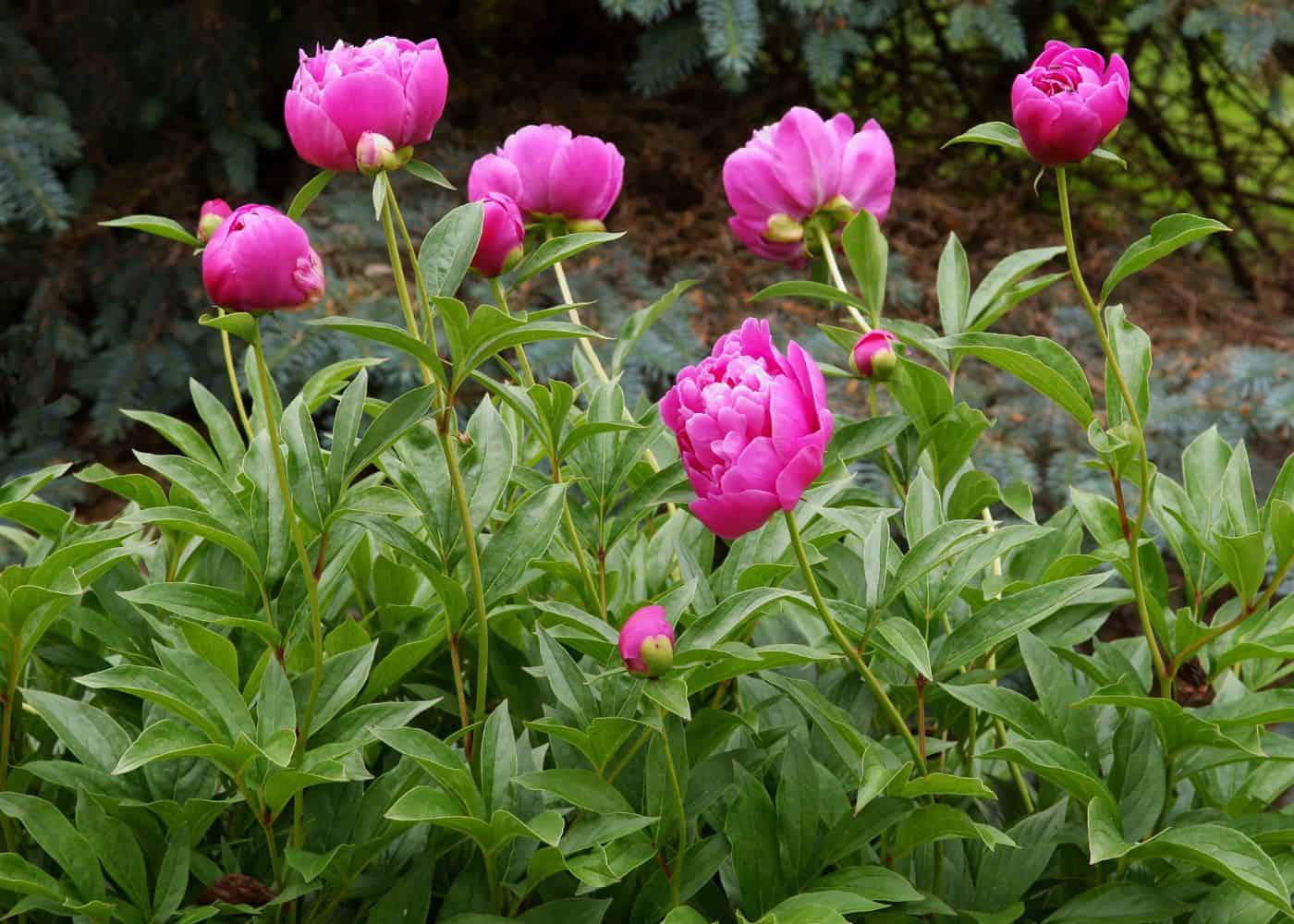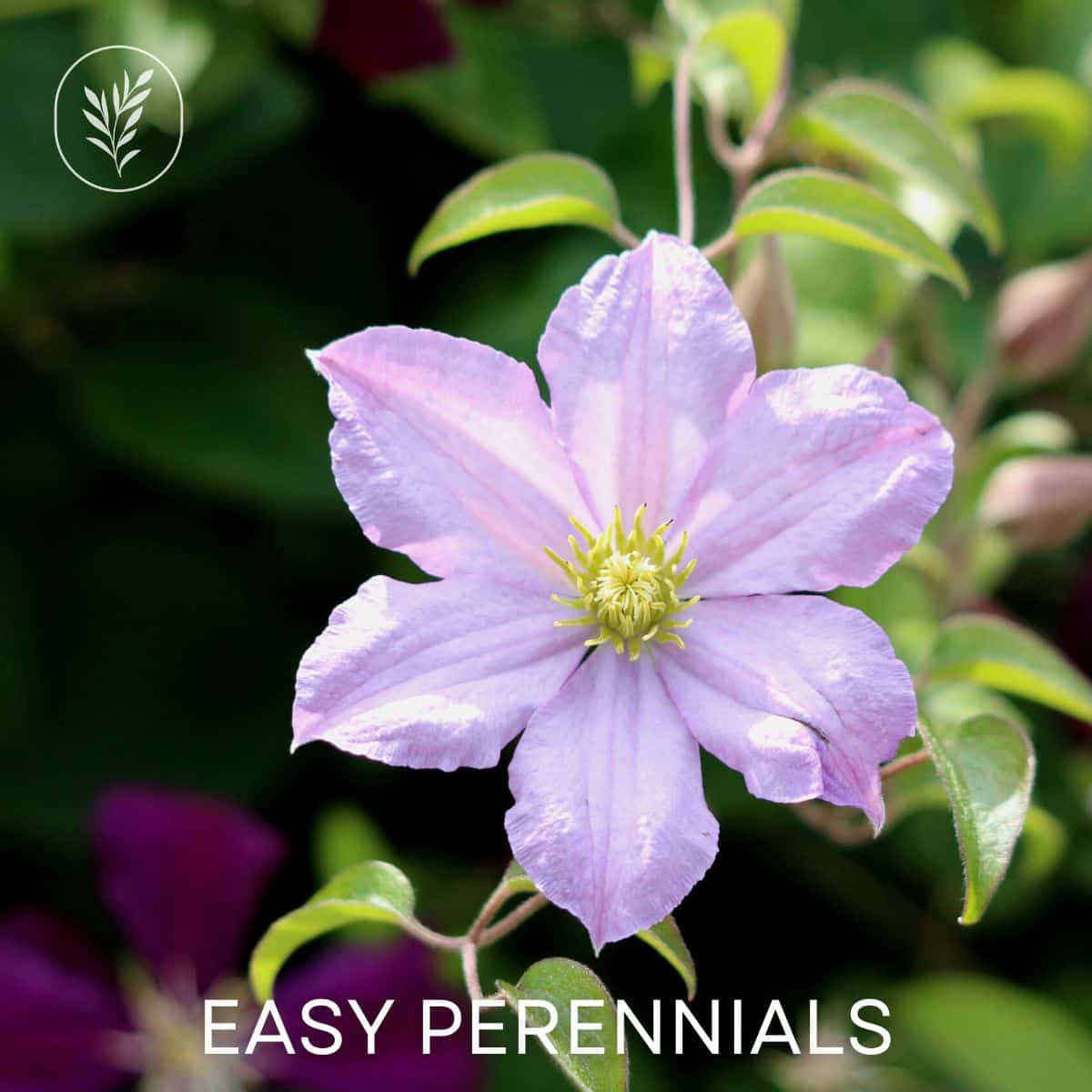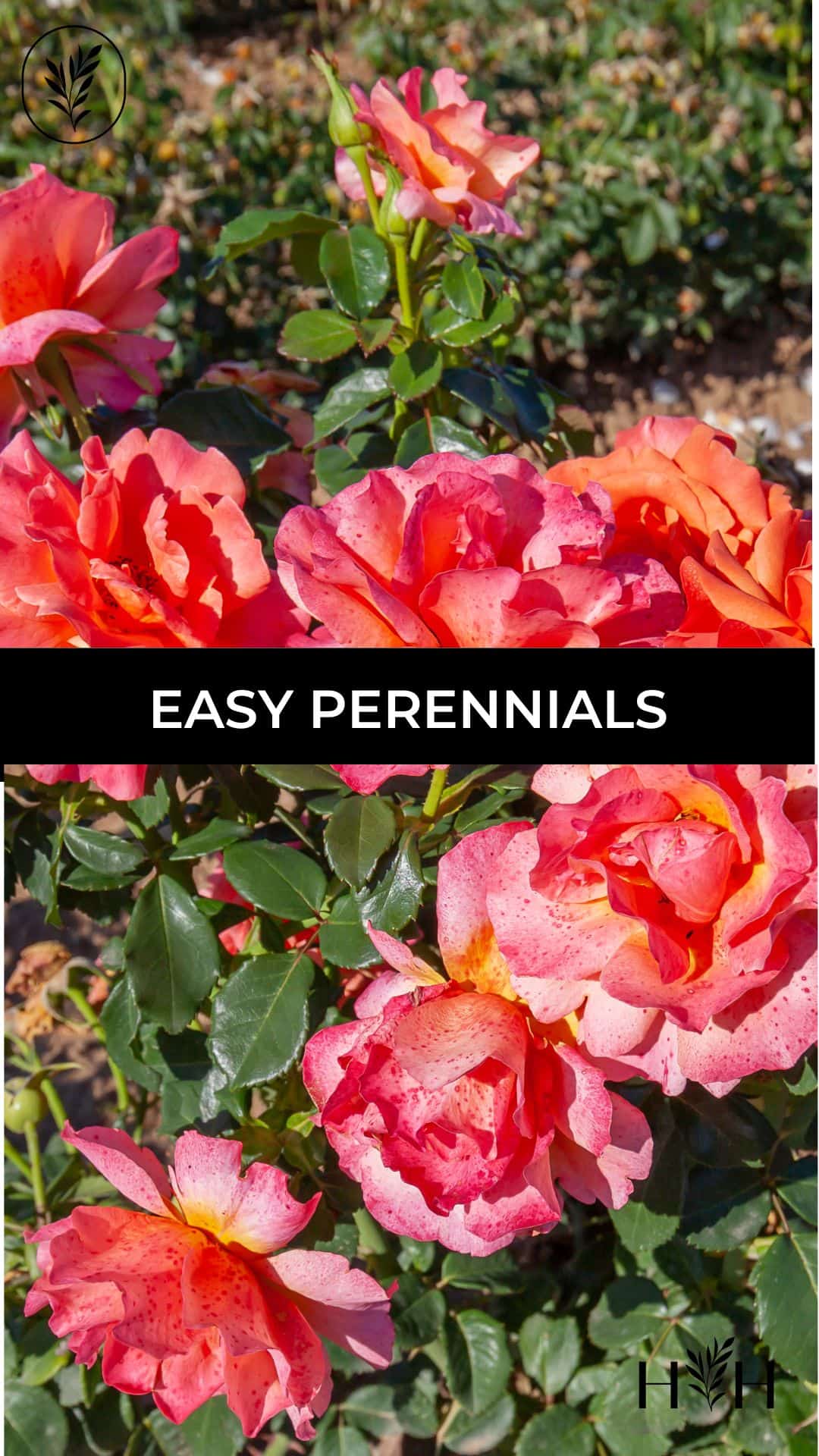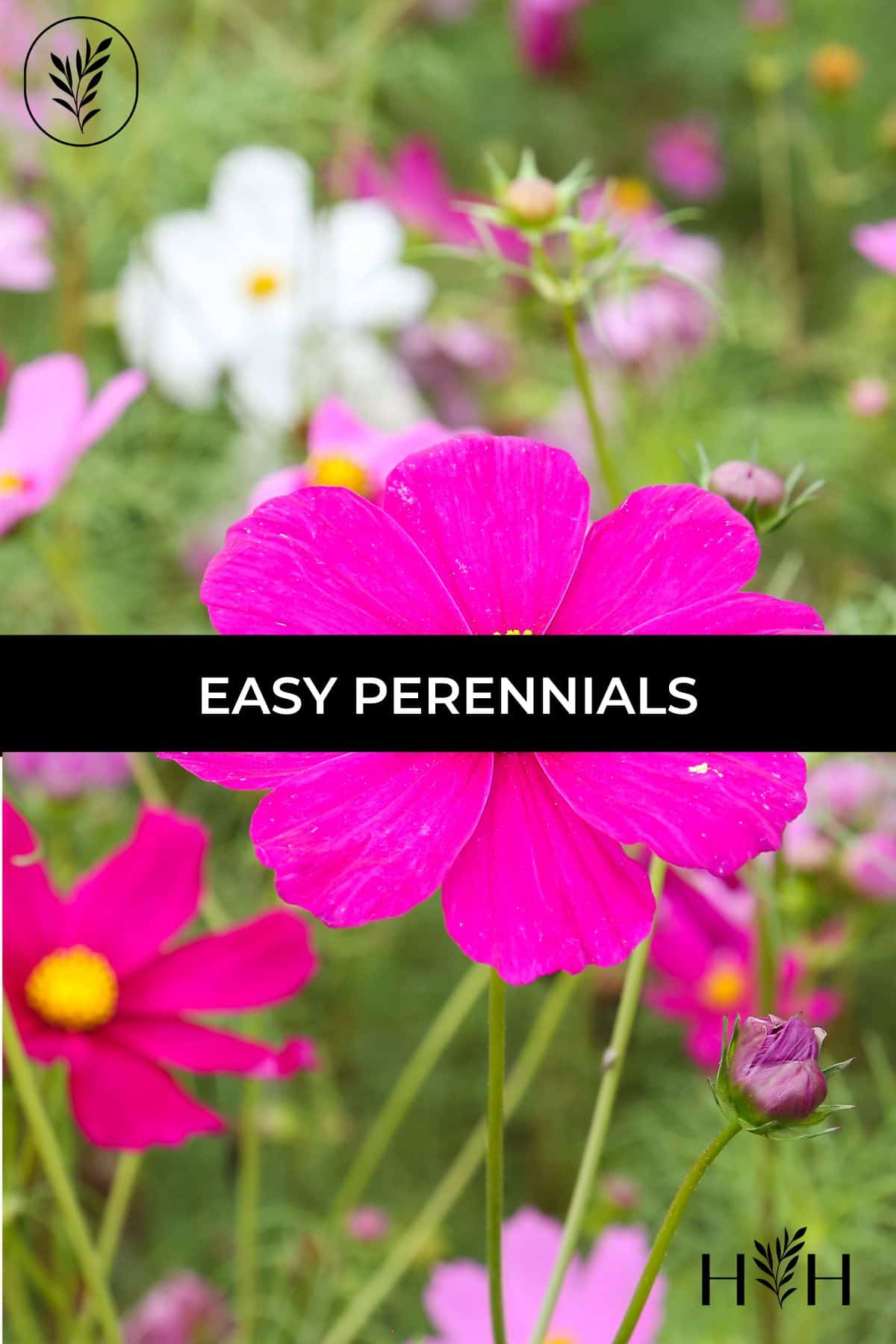Looking to grow a garden full of beautiful perennials? These 10 easy perennial plants are the best perennials to grow if you’re looking for low maintenance, drought tolerant, and gorgeous flower garden.
1. Peony
Peonies are beautiful perennial flowers that are very low maintenance. While they’re easy to care for, they have the capacity to last for decades. Your peony varieties will be the main attraction of your garden for many years! It is not uncommon for individual plants to thrive for up to 50 to 100 years.
Peonies are often thought of as pink flowers, but they do come in a few different colors: red, orange, yellow, and white. It’s best to plant peonies in early fall. If you find pre-planted peonies in early spring, that’s okay too. It’s always best to double-check your prime planting zone, depending on where you live.
Peonies need full sun exposure and well-drained soil. It’s best to plant by mixing compost and a minimal amount of fertilizer. It’s also important not to use too much mulch. Only when cold temperatures are harsh after the first year of planting, use mulch loosely with shredded bark or pine needles—but it needs to be removed by spring. The first frost is also a good time to prune your peony for next season growth. If you’re looking for great companion plants and flowers to grow alongside your peonies, check out 15 Perfect Companion Plants For Peonies!
2. Daylily
Daylilies are a flowering plant in the genus Hemerocallis which is in the Asphodelaceae family. These perennial flowers are known for being extremely easy-care perennials that require little to no maintenance! They are so low maintenance they have even been known to survive droughts! You can plant them in both spring, summer, or fall. However, the later you plant, they should be mulched to prevent heaving from the winter frost and colder climates (depending on where you live).
Despite being able to survive nearly any condition, it’s best to keep your daylilies in sun to part shade with well-drained and fertile soil. For newly planted flowers, it’s best to water them once a week until they are well on their way to full bloom. However, if you skip a week it shouldn’t harm them. If you don’t plan to cut them, be sure to remove dead foliage from the prior year’s growth before the next annual bloom.
3. Hostas
Hostas are hardy shade perennials that don’t require a lot of maintenance. There are hundreds of different varieties available, including mini hostas, blue hostas, and sun-tolerant hostas. Most types have purple or white flowers that bloom in midsummer. It’s best to plant them in early spring or early fall (as long as the summer heat has passed). Of course, it’s always best to check for your specific planting zone.
These perennial plants thrive in partial shade, and best to plant them in partial shade. They grow best in organic, rich soil. However, a loamy soil will not need added organic matter. It depends on your garden though. Ensure these hardy plants are well-drained with a slightly acidic pH. Want to learn more about hosta flowers? Check out A Gardener’s Guide to Hosta Flowers!
4. Iris
Iris are dramatic flowers known to attract beautiful butterflies and hummingbirds. The best time to plant these flowers is in late summer or early fall.
Iris grows best in full sun. They can grow with three to four hours of sun a day but it’s not ideal. If they don’t get enough sun, they won’t bloom at their best. These perennial flowers need well-drained and fertile soil with neutral to slightly acidic soil. They do need to be water fairly consistently—especially in a hot summer. However, it’s important to do research on how much to water them in your plant zone because overwatering the soil can cause the rhizomes to rot.
5. Coneflower
Coneflower plants, also known as Echinacea, is a genus of herbaceous flowering plants in the daisy family. They are best known for being heat-resistant, drought-tolerant, and deer resistant. Plus, they are super easy to grow!
They will do best if planted in spring after you are sure the last winter frost has passed. They can also be planted in early fall. Like many perennials, Coneflowers need full sun (six to eight hours a day) and well-drained soil. Coneflowers are surprisingly tolerant in poor soil, but if you want them at their best, ensure the soil is nutrient rich.
6. Black-eyed Susan
The Black-eyed Susan, also known as Rudbeckia, is from the Asteraceae family. It’s a native flower to North America known for being bright yellow and a black “eye” at the center. They are the perfect choice if you’re keen on a colorful garden.
They are best planted in spring or early fall. It’s primarily essential they are able to establish strong roots before the weather gets too hot or too cold. Black-eyed Susans require full sun (six to eight hours a day). They generally do well in many garden soil types except for soggy soil.
7. Salvia
Salvia plants are the largest genus of plants in the sage family Lamiaceae. They are an excellent choice if you love gorgeous purple perennial flowers. You can sow salvia indoors roughly 10-12 weeks before the last frost. Or you can direct sow two weeks after the last frost date.
Salvia prefers full sun to part shade and well-drained soil. However, most salvia species are drought tolerant and are low maintenance. If you water too much, it can increase the chance of fungal disease. Ensure they have slightly acidic soil for optimal outcomes in your spring garden.
8. Coreopsis
Coreopsis is a genus of flowering plants in the Asteracease family. They are also known as tickseed plants or calliopsis. These flowers are a native plant to North America and best known for being quaint, yellow flowers. They are often compared to daisies and make great plants for a spring garden.
It’s best to plant this species in early to late spring after the frost has passed entirely. Coreopsis needs full sun (six to eight hours a day) so find them a sunny spot in your garden. They will thrive in well-drained soil that is moderately moist. If planted in poor soil, you won’t see the results you’re hoping for.
9. Sedum
Sedum perennial flowers are also known as stonecrop plants. They are a large genus of flowering plants from the Crassulaceae family. Sedum attracts butterflies and other pollinators such as bees. They’re best planted in the late spring but can also be grown in the summer. They will easily rot if they’re not strongly rooted before winter arrives.
Sedums don’t need a lot of water, but they do need at least six hours of sun a day. They need well-drained soil with neutral to slightly alkaline pH, but are very drought tolerant. If wet and heavy clay soil is present, it will likely lead to root and stem rot. Because they are visually appealing all throughout the growing season, they are great for mass planting. Be sure to cut back plants after they are done flowering to encourage them to maintain sturdy growth
10. Lily
Lilies, also known as Lilium are a genus of herbaceous flowering plants that are grown from bulb-like roots. They are from the Liliaceae family and are most known for being large, colorful flowers. Lily bulbs are best planted in early spring. However, they can be planted in early fall as long as you give them enough time to take strong roots before winter frost.
This beautiful perennial needs to do well in full sun. This means they need a minimum of six hours of sun to part shade in order to thrive. Lilies can do well in most garden soil but will not do well in soggy soil. Organic matter will help build strong roots and help with its moisture retention.










